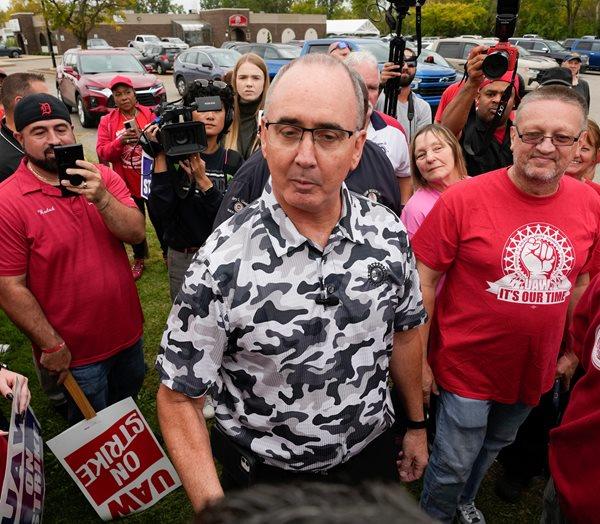
劳伦森银行(Laurentian Bank)在最近的财报电话会议上公布了喜忧参半的财务业绩,主要集中在客户体验、简化和技术投资方面。
尽管收入略有增长,但由于主机故障造成的高额费用,该银行的净收入和每股收益(EPS)同比下降。该行的贷款增长受到宏观经济状况的阻碍,但净息差的增加是一个积极的迹象。
该银行还宣布了新的高管任命,并正在修改其战略计划,对其产品和流程进行审查。该银行的信贷表现依然强劲,并对其投资组合的弹性充满信心。
净利润和每股收益同比和季度环比均有所下降。
营收环比增长4%,但与上年相比有所下降。
高昂的费用,包括来自mainf的费用名称中断,co导致了收入的下降。
银行的资本状况得到加强,CET1比率上升至10.2%。
贷款增长受到生态系统的负面影响经济状况,但净息差有所改善。
该行正在进行一项战略评估,预计将在春末公布。
宣布了新的高管和董事会任命。
该银行正专注于改善客户体验和技术基础设施投资。
该行预计,下一季度的贷款将减少,效率比率将略有上升。
节日预计Nal模式将在秋季提高利用率。
一项战略评估正在进行中,可能会有进一步的重组费用。
贷款增长面临来自整体经济的阻力的经济环境。
由于技术成本和相关费用的增加,非利息支出增加拉梅停机。
商业贷款组合和商业房地产活动减少。
住宅抵押贷款组合在审慎的承销标准下呈现增长。
该行的资本和流动性水平依然稳健。
交易部门表现不错贡献更高的收入。
总收入、净收入和每股收益与去年和上一季度相比均有所下降。
效率比因0而恶化正在进行的投资和与中断相关的费用。
在确保担保和信用保护方面,该银行在各个行业都采取了严格的方法。
oem和经销商没有对合同提出异议。
该银行预计,由于谨慎的公司,下一季度的贷款将略有减少消费者行为与商业地产项目延迟。
有关战略计划和投资者活动的细节将在今年晚些时候公布。
总而言之,劳伦森银行最新的收益电话会议描绘了一幅处于十字路口的金融机构的画面,在应对眼前挑战的同时,为未来的增长奠定基础。该行对客户服务、简化流程和战略性技术投资的重视,标志着该行致力于适应不断变化的金融格局。建议投资者和利益相关者期待未来几个月预计的战略评估结果,以更清晰地了解该行的发展方向。
接线员:欢迎来到劳伦森银行季度财务业绩电话会议。请注意,这通电话正在录音。现在我想把会议交给负责投资者关系的副总裁Andrew Chornenky。请继续,安德鲁。
Andrew Chornenky:大家好。早上好,感谢大家的到来。今天的开幕词将由总裁兼首席执行官éric教务长发表,第一季度财务业绩的回顾将由执行副总裁兼首席财务官Yvan Deschamps发表,之后我们将邀请电话提问。我们的首席风险官Liam Mason和资本市场主管Kelsey Gunderson也参加了提问环节。有关本季度的所有文件可在投资者中心的网站上找到。我想提醒您,在本次电话会议期间,可能会做出前瞻性陈述,实际结果可能与这些陈述中的预测存在重大差异。有关前瞻性陈述的完整警告说明,请参阅我们的新闻稿或演示文稿的幻灯片2。我还想提醒听众,银行在报告和调整的基础上评估其业绩,并认为两者在评估基本业务绩效方面都是有用的。éric和Yvonne在他们的评论中将参考调整后的结果,除非报告中另有说明。现在我把电话转到éric。
Eric Provost: Yes, Andrew. Good morning and thank you for joining us today. Over the past few months, I have had the opportunity to meet with many Laurentian Bank team members, and I consistently hear the same things. They are committed to this institution. They are driven to improving our operations and simplifying our structure. And they are dedicated to serving our customers. Throughout the quarter, we have remained focused on three priorities, customer focus, simplification and strategic investments to improve our technology infrastructure. I would like to thank every Laurentian Bank employee for their efforts while also supporting the organization in our strategic planning exercise. While Yvan will provide further details during his remarks, I wanted to offer some high-level thoughts and their overall performance. I am pleased to report that the bank strengthened its capital position in a time of continued macroeconomic uncertainty. We have managed our funding to our book of business. And given the reduction in loans due to the current environment, we executed on our planned deposit reduction activities while maintaining a strong level of liquidity materially above the industry average. We are comfortable with our commercial portfolio and are well positioned for a rebound later this year. As business conditions improve this quarter, revenues were slightly down compared to last year and grew by 4% on a sequential basis. Net income and EPS were both down year over year and quarter over quarter as expenses remained high. This increase included costs related to the mainframe outage last year, which impacted EPS by $0.04 this quarter. We know there is more work to do to reduce our expenses, and that is why simplification is a key part of our plan going forward. While overall loan growth was negatively impacted by macroeconomic conditions, including business and consumer sentiment, our NIM was up 4 bps to 1.8%. This quarter also saw a small rebound in capital markets related businesses with stronger trading results and fixed income. The business's results also benefited from recent rightsizing actions. Our credit performance remained strong with a small increase in PCLs compared to Q1 last year and stable versus last quarter. We remain confident in the portfolio and are adequately provisioned dealers and manufacturers in our inventory financing business remain cautious. Inventory levels are not rising to the levels seen in previous years, and as a result, utilization was at 50%. This is lower than the mid 50s utilization rate we would typically see at this time of year, given macroeconomic conditions, dealers and manufacturers are working together on floor planning programs. This shows strong partnership and provides us with significant confidence. As we look forward to the remainder of the year, we expect an increase in utilization starting in the fall. If interest rates adjust according to projections. Turning now to commercial real estate activities. We have seen a slowdown in construction start, which remains in line with our expectations as developers continue to adjust to the current cost environment. We have seen no cancellation of projects and our portfolio is in line with our credit appetite. The majority of our portfolio is in multi-residential housing, which continues to show resiliency as demand remains stronger than supply. As a reminder, we deal with Tier 1 and Tier 2 developers with significant experience through the cycles. We're pleased with how both commercial portfolios are performing. Our specialized approach gives us confidence as we continue to face uncertainty in the macroeconomic environment. As I mentioned earlier, this quarter also saw a plan year over year and sequential decline in deposits, and there are a few points I'd like to make. First, we manage deposit and loan activity on a relative basis. That's why we have executed on plan deposit reduction activities. This includes actions such as more conservative pricing in our broker deposit channel to maintain our focus on profitability, contributing to our NIM expansion. Second strategic partnership deposits function like conventional demand deposit products. Recent quarters have witnessed these deposits behaving like typical demand deposits, with funds being redirected towards market activities and other term deposits products consistent with our expectations. Third, personal deposits source through our retail channel are stable quarter over quarter. And personal deposits overall represent 86% of our total deposits contributing to the bank's sound liquidity position. In fact, this quarter we enhanced our action GIC and equity-linked product with a competitive minimum rate guarantee which are good pickup. We also held a very successful Black Friday campaign where total GIC sales exceeded last year's performance in the same period, further solidifying our funding sources. Operationally, we have a number of developments to share from this quarter. Beginning with our people, I'm pleased to announce three new appointments to my executive team. First, we have promoted Macha Pohu to the position of Chief Human Resources Officer as she'll succeed Sébastien Bélair who held this position for the past three years, allowing him to better focus on his role running retail and corporate operations. Macha joined the bank in 2022 and has more than 25 years of experience in the financial services sectors and distribution, information technology, and human resources. Second, I'm pleased to announce that has joined the bank as our new Chief Information Officer this month. Benoit is an accomplished technology and digital transformation leader with almost 30 years of experience. He has a history of managing large and complex IT programs as well as architecting and delivering innovative solutions. His mandate will be to align the bank's IT strategy with our overall business strategy, ensuring that our technology initiatives directly support our organizational objectives. Third is the creation of our strategy and transformation office, which will be led by Marie-Christine Custeau, who has almost 20 years of experience in financial services, including sales effectiveness, change management, and business process optimization. This new office will oversee the development, implementation, and evolution of the strategic plan, identify organizational priorities and ensure a steady pace of decisions that enable us to deliver value for our customers quickly. The office will work closely with finance to monitor the budget and maximize transformation goals. The bank also announced three new appointments to our Board of Directors, Mr. Johanne Brunet, Mr. Jamey Hubbs, and Mr. Paul Stinis. These appointments are part of the Board's commitment to ongoing renewal to enhance overall effectiveness and ensures an appropriate balance between skills and experience and a diversity of perspectives. Their backgrounds are varied and include marketing, risk management, capital markets and business development. Looking forward, we are fully engaged on the revamp of our strategic plan. This plan will refine our focus on the areas where we can win to increase our competitiveness while always maintaining our objective of improving the customer experience. As part of this refresh, we have launched an end-to-end review of all our products, projects, and processes to help inform our decision making as we look to simplify our operating model. This work is ongoing and we will make appropriate decisions about products and projects as we progress through this exercise. I will now like to turn the call over to Yvan to review our financial performance.
Yvan Deschamps: I would like to begin by turning to slide 8 to highlights the bank's financial performance for the first quarter. Total revenue was $258 million, down 1% compared to last year and up 4% quarter over quarter. On a reported basis, net income and EPS were $37.3 million and $0.75, respectively. Adjusting items for the quarter amounted to $6.9 million after tax or $0.16 per share and include amortization of acquisition related intangible assets and restructuring charges of $6.1 million or $4.5 million after tax, resulting from the previously announced simplification of the bank's organizational structure and headcount reduction. Details on these items are shown on slide 22. This quarter, an LRCN biannual interest payments had a $0.06 impact on our EPS. The remainder of my comments will be on an adjusted basis. EPS of $0.91 was down year over year and quarter over quarter by 21% and 9% respectively. Net income of $44.2 million was down by 19% compared to last year and 1% compared to last quarter. The bank's efficiency ratio increased by 360 basis points compared to last year and by 100 basis points sequentially. This uptick reflects our ongoing investments in strategic priorities and the remaining expenses related to the mainframe outage in September 2023, which totaled $0.04 this quarter on an EPS basis. Additionally, and as previously guided, there was a seasonal increase in salary and employee benefits. Our ROE for the quarter stood at 6%. Slide 9 shows net interest income down by $1.9 million or 1% year over year, mainly due to lower interest income from lower loan volume. On a sequential basis, net interest income was up by $2.4 million or 1%, mainly due to lower liquidity levels and lower funding costs, partly offset by lower loan volume. Our net interest margin was up 4 basis points sequentially to 1.8%, mainly for the same reasons. Slide 10 highlights the bank's funding position. Following a period of elevated liquidity, we gradually reduce our deposit bases considering the loan volume reductions and our previously stated objective of reducing our liquidity position. On a sequential basis, total funding was down $1 billion. Strategic partnership deposits decreased by $500 million as customers allocated funds back into market activity or term products. Deposits from advisers and brokers were also down by $300 million, mostly due to the natural runoff in our intentionally less competitive market rates. Despite the reduction in liquidity, the bank maintained a healthy liquidity coverage ratio through the quarter, which remains materially above the industry average. Slide 11 presents other income, which was relatively unchanged compared to last year. Higher income from financial instruments was mostly offset by lower lending fees due to tempered commercial real estate activity and lower income from mutual funds. On a sequential basis, other income increased by 8.5 million or 13% as a result of higher income from financial instruments due to more favorable market conditions and higher service charges as two months of fees were waived during Q4 2023. This was partly offset by lower lending fees. Slide 12 shows non-interest expenses up by 4% compared to last year, mainly due to higher technology costs, as the bank is investing in its infrastructure as well as higher professional and advisory service fees related to mainframe outage that occurred last quarter. This was partly offset by reduced headcount and lower performance-based compensation. On a sequential basis, non-interest expenses were up 6%, mainly due to seasonally higher vacation accruals, employee benefits, and performance-based compensation, partly offset by lower advertising fees. This quarter, the remaining remaining expenses related to the mainframe outage in the fourth quarter totaled $0.04 on an EPS base. Turning to slide 13, our CET1 ratio was up 30 basis points to 10.2 due to a reduction in risk weighted assets. Slide 14 highlights our commercial loan portfolio, which was down about $1 billion or 6% year over year and was down $500 million on a sequential basis, mostly due to slowing real estate market activity and our inventory financing dealer base being prudent in the current macroeconomic environment. Slide 15 provides details of our inventory financing portfolio. This quarter, utilization rates were 50% and are lower than historical levels as dealers have been taking a more conservative approach to inventory. We expect utilization rates to follow the usual seasonality, which includes a reduction in the spring and summer periods before starting to increase in the fall. Commercial real estate, our unfunded pipeline, has been impacted by market trends but remains healthy. We have seen some developers slow down the starts of projects given the current macroeconomic environment as they navigate through this period of high inflation and interest rates. However, demand in the region residential real estate continues to exceed supply. As seen on slide 16, the majority of our portfolio is in multi-residential housing, and only around 3% of our commercial loan portfolio is in office. Our office portfolio consists of Class C or B assets in financial recourse to strong and experienced sponsors. As we have said over the past few quarters, the majority of the portfolio is in multi-tenanted properties with limited exposures to single tenanted buildings. Slide 17 presents the bank's residential mortgage portfolio. Residential mortgage loans were up 5% year over year and 2% on a sequential basis. We maintained prudent underwriting standards and are confident in the quality of our portfolio as it is evidenced by the high proportion of insured mortgages at 58% and low LTV of 51% on the uninsured portion. It's also worth noting that more than 80% of our residential mortgage portfolio is fixed rate, of which more than 80% will mature in 2025 or later. The allowances for credit losses on slide 18 totaled $218.5 million, up $15 million compared to last year, mostly as a result of higher allowances in the commercial portfolio. Allowances for credit losses increased by $3.7 million sequentially, mostly as a result of higher allowances on commercial loans due to credit migration, partially offset by write-offs in the commercial and personal loan portfolios. Turning to slide 19. Provision for credit losses was $16.9 million, an increase of $1.5 million from a year ago, reflecting higher provisions on performing loans. PCLs were essentially in line with last quarter. As a percentage of average loan and acceptances, PCLs were unchanged at 18 bps. Slide 20 provides an overview of the impaired loans. On a year-over-year basis, gross impaired loans increased by $73.9 million and were up $16.5 million sequentially, mostly in the commercial portfolio, which is well collateralized. We continued to manage our risk with a prudent and disciplined approach and remain adequately provisioned. As we look ahead to Q2, I would like to note a few key points focused on the next quarter. We expect our loan book to continue to be impacted by macroeconomic conditions as dealers continued to be prudent in restocking inventory and due to lower level of activity on the real estate projects. Adding the impact of the lower number of days, we expect a low single digit and IR reduction for Q2. Same is expected to remain relatively stable. We are committed to reducing our efficiency ratio, and we'll share more details with you later this year as part of our revamped strategic plan. For the second quarter, we expect a slight increase of our efficiency ratio due to the pressure on revenues I just mentioned and as we incur expenses to support the review of our strategic plan. Given the macroeconomic environment, PCLs are expected to be in the high 10s or low 20s. Capital and liquidity levels are solid and expect to remain strong for Q2. I will now turn the call back to the operator.
接线员:[接线员说明]。第一个问题将由丰业银行的曼尼·格劳曼提出。
曼尼·格劳曼:大家早上好。我有个关于战略评估的问题。你还能提供给我们一个时间表吗,我们什么时候能从你那里听到一个更令人满意的计划?Eric Provost,加拿大劳伦森银行总裁兼首席执行官早上好,Meny。埃里克。就时间而言,我们表示我们的目标是在春天,我将在春天晚些时候澄清。因此,我们的团队正在努力实现这一目标,并将实现更多目标。
格劳曼:好的。我很感谢你在最后强调,那个学期的费用会更多。但我只是想知道更多的概念,感觉就像减少所需的费用,似乎很难相信这可以在没有进一步重组费用的情况下完成。所以我想知道您是否可以对此发表评论,比如我们的费用管理过程如何有机?你讲了很多简化。听起来你想做的事情需要重组费用。它们听起来更有戏剧性。所以我想听听你的看法。
Eric Provost:嗯,Meny,正如你所注意到的,就像我们上个季度已经开始裁员2%。我们的分析的一部分,然后试图简化这个组织,我会说,是的,需要进一步的重组费用。现在债务问题已经解决了,当我们带着战略计划回来的时候,这个问题仍然需要解决。
格劳曼:好的。然后可能只是相关的,我的意思是,我认为好消息是,显然你们的资本状况相当强劲,本季度再次上升,CET1达到10.2%。你在流动性方面采取了不那么防御性的姿态。我想知道这如何转化为你对资本的看法和你对过剩资本的看法,以及你的CET1比率应该在哪里。你们有什么想法吗,你们有多大的灵活性?现在你的资本比率是10.2%,你对它的看法有不同吗?
Eric Provost: Meny,很好的问题。我们在上个季度表示,我们将管理10%或以上。而现在,我们的利率是10.2%,相对于整体宏观经济形势,我们感觉相当不错。我们仍在关注未来通胀和利率走势的演变。所以我们现在感觉很好。
接线员:下一个问题来自蒙特利尔银行资本市场的索拉博·莫瓦赫迪。
索拉博:好吧。我要很快地跟进一下梅尼。我认为资本比率下降的部分原因是因为贷款增长较低。RWA消费稍微低了一点,你预计它会反弹。这是正确的思考方式吗?
伊万·德尚:索拉博,这是伊万。所以我就买这个。所以你是对的。所以资本的增加基本上来自于RWA的减少。
Sohrab Movahedi: RWA的减少是因为利用率降低了。
德尚:没错。如你所见,商业广告减少了。从RWA的角度来看,这是一个巨大的资本消费者。所以这基本上来自于那次撞击。是的。
索拉博:好吧。我的意思是,我想,伊万,我想在这里重申一下梅尼的观点,我的意思是,或者éric,抱歉。我认为在过去的五个季度里,我的意思是,即使你调整了一些一次性的收益,也在4000万到5000万美元之间。这是一个很大的摆动或范围。我们需要这个战略回顾来了解劳伦森银行将会成为什么样的组织从而了解它未来的盈利潜力。所以我想你越早给我们一些信息越好。这不是问题,这是陈述。但我只是,我觉得在不知道什么有用的情况下,很难做出投资决定。谢谢你!
埃里克:谢谢你,索拉博。就像我说的,我们正在努力以正确的方式进入市场,这样我们就有了所有的分析。最重要的是要确保这个组织非常非常关注这个客户群,了解我们可以在哪里获胜,简化我们的结构和产品货架,保持我们在基础技术上的投资,以运行银行,同时确保我们为各种平台创造额外的收入。
接线员:下一个问题来自国家银行的加布里埃尔·德尚。
加布里埃尔·德尚:早上好。我想简单说一下另一项收入。第一,服务费用,尤其是服务费用,上个季度由于it问题,你们可能削减或退还了服务费用,现在已经稳定下来了,还是已经度过了最糟糕的时期?我想那已经完全消失了。
德尚:没错,加布里埃尔。所以在第四季度有两个月的减免,大约200万美元,这就是这个季度的差异和改善。所以它相对稳定,不包括我们在第四季度看到的费用减免。
加布里埃尔·德尚:好的。然后是投资收益或投资工具,不管它叫什么,那1200万美元,背后是什么?
凯尔西·甘德森:嘿,加布里埃尔。我是资本市场的Kelsey Gunderson。我认为我们通常在这方面的指导在600万到900万美元之间,显然本季度取得了不错的成绩。我认为这显然反映了对我们贸易商来说更具建设性的市场。我们在这方面处于有利地位,我们能够参与更好的市场。所以我不会把这解读为任何策略上的改变。我在交易台看到了一个不错的季度。
加布里埃尔·德尚:好的。流动性一直在减少。我们没有LCR比率,我们可以看那种跟踪。我知道我们上个学期讲过这个。这是你可以使用的内部测量。但我想我能看到的是存贷比现在接近150%。你对这个水平感到满意吗?我们还能看到更高的水平吗?市场预期存贷比会下降,而不是上升在当前的市场环境下,未来可能也是如此。
德尚:谢谢你,加布里埃尔。因此,我们管理银行资金的方式是,我们关注存款和证券化,这是长期的,非常具有成本效益的资金。所以如果你把这两个和贷款相比,我们试图保持它们相对一致。如果你从本季度的数据来看,我们是1.03。这就是我们管理它的方式。这不仅仅是存款和贷款的问题。这实际上是一个证券化加上存款和贷款的问题。我想说,我们目前处于一个积极的领域,因为我们打算将其控制在1左右。
加布里埃尔·德尚:好的。谈到存款,我想这是另一个NIM问题,你确实谈到了更低的融资成本。随着贷款的减少,我并不是在鼓掌欢呼,但好在你在融资时可以更有选择性,在一些更高的成本下,资金来源会减少。我只是想知道,当我看你们的融资图表时,我忘了是哪一张幻灯片了,但你认为哪一张对NIM这个季度最有利?然后我们再深入探讨一下战略合作伙伴关系——我知道在当前的管理团队之前,责任或者你想怎么说,这是融资结构的一部分,之前是大张旗鼓地宣布的。现在损失了大约15亿美元,我想知道这个战略会有什么变化,如果有的话?
伊凡德尚:谢谢,加布里埃尔,我也要这个。所以在NIM方面,正如你提到的,4个基点的改善来自于本季度流动性的减少,我们采取了行动,我们上个季度指导了你。但我想说,这也可能来自于,我们不得不承担的稳定利率的一些追赶。这就是一直在发生的事情。我想说现在大部分都是囊中之物了。但正如你所提到的,我们在未偿还贷款方面一直很谨慎。所以,当你在发展方面保持谨慎的时候,这在边际上是有益的。所以我想说,这解释了大部分问题。当然,我们在存款方面不那么积极,这肯定会影响产品的利润率。如果我讨论战略存款或合伙存款,我们必须记住的是活期存款。因此,从技术上讲,闲置资金正在等待更好的市场,这就是我们最近所经历的情况。当然,同样的趋势是,这些资金又回到了市场投资和高回报的政府债券或其他类型的投资。这是可以预料到的,你应该预料到这条线会继续下降除非市场有很大的波动。但随着我们看到市场越来越好,这条线应该是稍微其他活期存款和其他行业。
加布里埃尔·德尚:明白了。这说得通。你说活期存款,但我认为它们不是零成本,(听不清)?
Kelsey Gunderson:对,没错。区别在于,我们可以简单地重申一下正常的活期存款。如果我们愿意,很乐意这么做。但这里的关键因素是我们与一些客户签订了一些多年协议。我们代表他们管理,他们客户的闲钱的活期存款。
加布里埃尔·德尚:好的。最后一个,如果我在你的评论中错过了这个,我很抱歉,我可能确实错过了。但为了更清楚地了解设备库存财务,平衡趋势和前景,a,本季度的季节性影响。第二,终端用户需求可能会下降,这意味着这类产品的增长更少,甚至是负增长,你怎么说?
Eric Provost:是的,Gabriel。éric,我来回答这个问题。这是一个很好的问题,我们确实看到我们的经销商在进货季节更加谨慎。你提到了季节性。通常,在一年中的这个时候,我们的生产线利用率在50%左右。当季结束时,我们的增长率为50%。因此,在一年中的特定时间,线的使用低于正常趋势,因为交易商看到市场仍然存在一些不确定性,无论是利率还是通货膨胀率。实际上,几周前我在迈阿密参加了游艇展,你可以看到并感受到,经销商正在接待客户。消费者是为了这些产品而存在的,但这些产品的转变速度会比较慢。我们喜欢经销商在补充库存方面更加谨慎的做法。因此,我们希望,如果今年晚些时候利率下降,今年秋天晚些时候信贷额度的利用率会有所增加。
接线员:下一个问题来自Veritas的Nigel D'Souza。
Nigel D'Souza:谢谢。早上好。如果你已经涵盖了这一点,那么很抱歉,但是你的商业投资组合中是否有突破类别,导致本季度商业贷款拨备增加?
梅森:早上好,奈杰尔。我是投诉专员利亚姆·梅森。这是跨投资组合的广泛的一般迁移。很明显,正如éric所阐述的那样,我们看到商业地产的发展放缓,我们也看到了这个领域的压力。但是对于我们的投资组合,广泛的只是跨商业投资组合的一般迁移。奈杰尔,我们对所有这些类别的储备都很严格,这反映在我们本季度的pc上。
Nigel D'Souza:对本季度库存融资对准备金的贡献有什么看法吗?
威廉·梅森:这只是投资组合的一部分。正如éric所说,我们很高兴我们的经销商在补充库存方面非常谨慎,但在经济周期的这一点上,你会预料到一定程度的迁移。
Nigel D'Souza:好的。如果我可以换个角度,我只是想确保我理解了存款动态和流动性评论。所以我的理解是,如果存款减少,就会减少你的现金流出压力,从而提高你的流动性覆盖率。或者你是在暗示你在降低存款水平的同时也在减少高质量的流动资产?我只是想了解存款和LCR之间的关系。
德尚:奈杰尔,完全正确——首先,LCR包括存款,包括银行的一般资金,当然,正如你提到的,我们拥有的其他流动性篮子。所以这是一个大趋势。我想我只是想通过讨论存款来简化问题,这可能是等式中最简单的元素。所以当我们把这些都考虑进去的时候,我们仍然管理着相当高的LCR水平。我们的业绩明显高于行业平均水平或六大公司。所以我们被提升了。鉴于宏观经济的变化以及近期发生的事件,我们建立了流动性储备。因此,从流动性的角度来看,我们仍然处于有利位置,非常安全。当我提到本季度存款减少时,我只是重申我们是根据贷款的情况来管理证券化和存款的。本季度的不同之处在于,如前所述,我们的目标是减少这一比例。我们在存款和存款利率上没有那么激进,这正是它所创造的。正如你所看到的,受影响最大的是新加坡政府投资公司。这减少了2亿美元,因为我们在利率上不那么激进了。
Nigel D'Souza:我只想澄清一点。简单地说,如果你的存款余额继续下降,这是会增加你的LCR比率,还是会保持稳定?保持较高的LCR比率当然是有代价的,因为你似乎不需要这样做来应对存款外流。
Yvan Deschamps:随着存款的增加,LCR也会增加;存款越少,LCR就越低。但这不仅是存款或流动性的问题,LCR也是未来三个月所需资金的问题。所以它确实取决于体积,它确实取决于我们的承诺。所以有很多方面影响着LCR,你必须把所有这些都放在布丁里,保持谨慎,这就是我们在LCR方面所做的。
接线员:[接线员说明]。下一个问题来自加拿大皇家银行的Darko Mihelic。
Darko Mihelic:嗨,谢谢。我有几个简单直接的问题,请耐心听我说。第一个问题是本季度的大型机宕机费用包括专业费用和其他费用。你能提供一些颜色吗?这是你对下个季度及以后的看法吗?从本质上讲,我想知道的是是否需要更多的顾问或更多的工作仅仅是为了这一点,如果这是未来费用压力的一部分,或者费用压力真的与其他事情有关?
德尚:是的。谢谢你的问题,Darko。好吧,请允许我澄清一下。如你所知,宕机发生在9月的最后几天,持续了10月的两天。所以修复工作基本上是在10月和11月初完成的。所以我们现在看到的是与停电补救有关的剩余费用。所以这不会影响第二季度的继续。由于其他因素,包括与正在进行的战略计划相关的一些支出,预计第二季度的支出水平将大致保持不变。但可以肯定的是,我们在10月和11月所做的修复中断的事情影响了费用,第四季度影响了300万美元,第一季度影响了200万美元,但应该不会再影响第二季度了。
Darko Mihelic:好的。但我明白——也许我——我必须回到我的笔记中去核对一下。但我之前以为,是免除学费,但这次不一样。还是我想错了?
伊凡·德尚:如果我的同事们想坦白,我会接受并向他们开放。但上个季度,我们减免了两个月的200万美元费用。但除此之外,我们还有大约300万美元的费用来弥补和纠正我们上个季度必须纠正的错误。所以总的来说,我的意思是,如果你把两个季度加在一起,我们有200万美元的费用减免,这只是在第四季度,没有影响到第一季度。我们有500万美元的专业费用和开支,其中300万是在第四季度,200万是在第一季度。所以严格来说,总共七百万美元,现在已经过去了。
Darko Mihelic:好的。非常感谢你的澄清。我很抱歉,我的笔记不在手边。那么现在,在事实发生之后,考虑到中断和必要的进一步补救措施,是否对客户体验进行了任何工作?
Eric Provost:是的,Darko, éric。早上好。今天早上,我很高兴地宣布,我们有了一位新的首席信息官,伯努瓦·伯特兰。就我们这边的客户体验而言,这是一个持续的改进。因此,我们将继续对我们的技术进行一些基础投资,以改进我们的技术。在那之后,就是简化我们如何满足客户需求的问题了。这些都将融入到我们的战略评估和战略计划中。春天还会有更多。
Darko Mihelic:好的。最后,我还想回到对PCL的指导,特别是下个季度,高10到低20。是我们在观察名单上看到的吗?或者这与第二季度的储备表现有关?任何颜色都可以。
威廉·梅森:当然可以,达科。是利亚姆,利亚姆·梅森让我带你们回顾一下我们所做的关于acl的历史。如果你还记得COVID之后,我们一直在根据我们表现组合的前瞻性预期系统地建立我们的储备。我们继续有系统地做空,为宏观经济条件做好准备。所以我想说的是,无论是在表现上还是在观察名单上。我们在如何在观察名单和训练中设定个人储备方面非常自律。更广泛的行业已经看到了房地产内部的一些压力,正如我们和其他参与者所表达的那样。但我们对我们的后备人员非常严格,无论是在表现方面还是在具体的观察名单文件方面。
接线员:下一个问题来自Desjardins的道格·杨。
Doug Young:嗨,早上好。希望能尽快澄清一下。回到经销商的库存发现,你看到50%的利用率,可能会在接下来的几个季度下降,然后在秋季回升。我想我想知道的是,第二季度和第三季度的50%都去哪了?然后依次来看,这对你的贷款账簿有什么影响?所以我只是想弄清楚,在接下来的几个季度里,我们还能看到多少收缩。
Eric Provost:是的,Doug, éric在那里。就利用率而言,我们预计今年夏天消费者在市场上的做法仍将是谨慎的。如您所知,我们在不同行业提供的各种产品都是季节性的。因此,我们应该预期利用率仍会有小幅下降,但具体到什么程度,将取决于通货膨胀等宏观经济因素和利率政策的行为。所以我们有一个谨慎的消费者。所以我们预计会有小幅度的减少。但从某种程度上说,现在这个赛季还为时过早。
道格·杨:就贷款金额的影响而言,你们是否也在增加交易?比如这里是否存在抵消所以你现有的利用率下降了?你是否在这里增加了新的投资组合或新的交易商,这可能会有一点抵消?还是说你们现在不打算做那种扩张?
Eric Provost:是的,Doug,这是一个很好的问题。实际上,我们一直在表明,我们正在寻求在行业组合方面实现整体投资组合的多样化。因此,团队在农业、建筑、技术等方面做出了努力,这些方面的季节性较少,也可以提供很大的多样化。但我要说的是,通过这些努力,我们的经销商数量增长到了400多家,年增长率约为8%。所以,是的,我们继续看到我们的经销商基础的有机增长,这肯定会为有机增长创造更多的动力,未来多元化的经销商。
Doug Young:好的。然后,也许只是回到信用,我再次道歉,如果我错过了这个。但在执行贷款账单上,这都是信贷迁移。在商业书中,有模型更新吗?引擎盖下面还有什么东西吗?
William Mason:谢谢你,Doug。又是利亚姆。没有型号更新。我知道我们的一些竞争对手提到了这一点。我们在设定宏观经济条件方面非常自律。对于预测,我们以行业和加拿大银行为基准。所以真正推动它的是移民和对宏观经济状况的前瞻性看法。
Doug Young:好的。最后是开支。我没听错吧,基本上不包括重组费用,因此调整了预期费用基数,预计第二季度与第一季度相对持平。我的信息传递正确吗?
德尚:是你,道格。
接线员:下一个问题来自雷蒙德詹姆斯公司的斯蒂芬·博兰。
Stephen Boland:谢谢。第一个问题是,你之前谈到过库存融资的不同垂直领域,你在这些不同的垂直领域增加了经销商。我想知道你是否得到了与你在传统的筒仓中所得到的相同类型的保护或契约。在担保方面,在实际的信用保护方面,我想知道这方面是否有什么变化?
Eric Provost:是的,Stephen,这是个很好的问题。在我们的运营模式中,方法总是一样的。所以我们总是从OEM开始,并试图确保。我们有95%的原始设备制造商回购,无论我们追逐的是哪个行业。在那之后,以批发价格为资产融资,为整个生产线的使用获得PG和经销商的担保,当然,所有这些都与DOEM的回购有关。所以,无论我们追求的是哪种行业,我们都坚持同样的原则。
Stephen Boland:就这些协议而言,oem或经销商没有任何阻力吗?还是说,如果他们想获得你的融资,就必须这样做?
Eric Provost:嗯,对我们来说,这是我们给自己的有纪律的方法,我们仍然忠于它。这就是我们认为好的公司能够经历周期的原因。所以我们的做法是一致的。这就是[听不清]
Stephen Boland:好的。我的第二个问题,如果这很明显,我很抱歉,我不确定你是否提到过这个。但是你给了我一些指导。我记得上个季度你谈到贷款账簿在整个2024年都是稳定的,也就是说每年都是稳定的。首先,这是正确的吗?现在改变了吗?显然,第一季度会大幅减少,但在2024年底或2023年底,它是否仍有望保持稳定?
德尚:斯蒂芬,我不记得我说过24年和23年会是稳定的。我想我通常一次引导到25美分。我们预计下个季度的贷款可能会略有减少,因为我们仍然保持谨慎,我们的客户仍然受到当前经济环境的影响。我们提到了库存方面,他们在补充库存方面非常谨慎。在商业地产方面,我们看到推动者正在推迟一些项目,等待或期待降低利率。因此,预计这将对下一季度产生轻微影响,虽然影响不大,但只是小幅下降。
接线员:谢谢。这就是我们的提问时间。我现在把会议交给éric。
Eric Provost:谢谢你今天的加入。随着我们进入第二季度,我们的重点仍然是我们的三个战略优先事项,以客户为中心,简化和战略投资,以改善我们的技术基础设施。我们将继续努力修改我们的战略计划,并期待在今年晚些时候有更多的消息,包括我们即将举行的投资者活动的更多细节。谢谢你!
接线员:谢谢。女士们先生们,今天的电话会议到此结束。再次感谢您的出席,此时,我们确实要求您断开线路。
本文是在人工智能的支持下生成的,并由编辑审阅。欲了解更多信息,请参阅我们的T&C。
为您推荐:
- 美国汽车工人联合会称罢工将不提前通知 2025-07-08
- Pro Research:华尔街关注沃尔玛的战略举措 2025-07-08
- 勒沃库森将主场迎战多特蒙德,迎战拜仁猎人 2025-07-08
- 财报电话会议:劳伦森银行在战略改革中取得喜忧参半的业绩 2025-07-08
- 加沙抗议者扰乱了巴黎索邦大学 2025-07-08
- 俄罗斯情报负责人:西方在乌克兰的失败增加了对俄罗斯挑衅的可能性 2025-07-08


